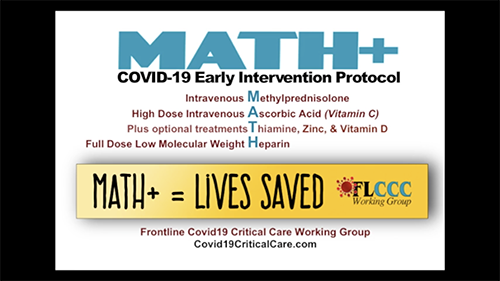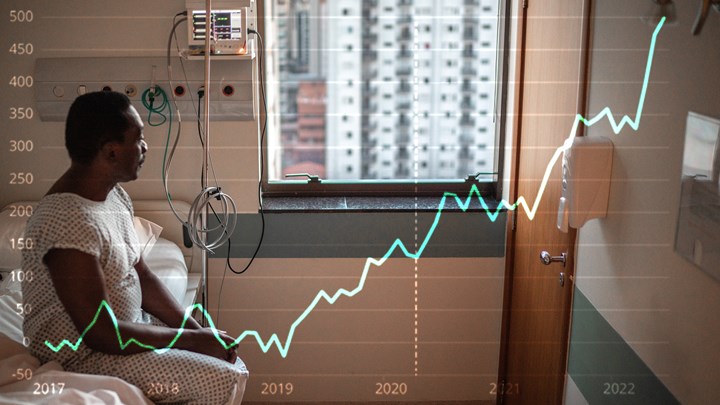Content Sections
After around 8 weeks in lockdown and 3 months since the spectre of Covid-19 loomed large in our media headlines, why is it that a team of frontline critical (intensive) care doctors in the USA who have delivered close to 100% survival with their unique protocol being roundly ignored? Wouldn’t you think that hospitals and governments would be biting their hands off to get a hold of their protocol? Or clamouring for more information and training to understand why their own outcomes from standard care fall so far short, delivering around just 50% survival in most critical care settings?
We certainly would, which is why we’ve dug a little deeper into the available critical care data for this article.
-
Find related articles, information and videos in our Covid Zone
It’s now very clear that the outcomes among the very seriously ill patients in critical care units (also referred to as ICU [intensive care units]/ITU [intensive therapy units] in the UK) are being used to inform lockdown (or lock up!) strategy and keep the fear levels sufficiently high to ensure citizen compliance.
Is there flex in critical care protocols?
Limited published data would suggest that critical medical care in many parts of the world is not flexing sufficiently to encompass treatment options to deliver the best possible outcomes, especially where these involve novel protocols and especially natural therapeutic agents. But why not? After all, this is the digital age where physical distance or time zone differences no longer present barriers to communication. The media is certainly sharing horror stories globally, many of which centre around the dire outcomes of the critically ill filling up the ICUs.
It’s impossible to over-estimate how important outcomes in these critical care settings are. High levels of success would significantly reduce the pain and suffering for the diseased, their families and their loved ones. It would also change greatly our perception of the threat posed by the disease.
To expedite research around this new infection, the obstacle course posed by the peer review process to scientific publication has been removed. Yet, despite many front line doctors using different protocols to the standard, conventional care, to great success (aka. better survival) their data are not being received where it counts. We all need to be asking why. After all, people are dying. How would it make relatives feel if it was found that their loved one had died needlessly just because the doctors who were having greatest success were not being listened to and their innovative protocols had been systematically ignored?
Survival outcomes that shouldn't be ignored
Dr Pierre Kory, and his colleagues in the Front Line Critical Care Working Group (FLCCC) are certainly demonstrating outcomes that shouldn’t be ignored, but are.
Dr Kory stated in the US Homeland Security Committee Round Table on Covid-19 last week, that their protocol has gone to the White House on 4 occasions, they have a website, have been widely interviewed for videos as well as print, yet no one in authority has tried to make contact. Worse, he states that they are being pushed back continually by the US Centers for Disease Control (CDC) and the National Institute for Health (NIH).
It’s no wonder he sounds so impassioned. Can you imagine how difficult it is for a team of experienced critical care doctors to see outcomes change dramatically from the normal standard of care to 98% survival with their MATH+ protocol, yet no one seems interested? Having now treated 100 critically ill patients, they report that they have only lost two people, both who were over 80 years of age with advanced chronic conditions. The rest were discharged in good general health after short hospital stays and none were ventilator dependent.
Surely that’s news that every hospital would be all over and we’d be seeing changes to the standard of care? Yet nothing of the kind appears to be happening. Instead Kory and his seven colleagues are being effectively stonewalled whilst more people die.

What do the data say?
The first thing to say is that data comparisons are in any event very difficult owing to different resources available, different patient characteristics and vulnerabilities, ages and ethnicities etc. Additionally, only around 12 studies from critical care facilities are published and only 3 of these, one from China, one from the ICUs of the Lombardy region of Italy and the comprehensive data from ICNARC in the UK involve over 1000 patients. Of these large studies, the Chinese and UK data suggests survival rates of almost exactly 50% and the Lombardy study stands out with its significantly higher survival at 75%.
Four studies from the US are all small and one involves the report of the total number of cases treated by a team of clinical care doctors working in different facilities, but using the FLCCC Working Group MATH+ protocol, which as we've described above, has only disclosed 2 deaths in 100 patients. This is the real stand out figure. Another US study from Boston showed 83% survival and an earlier study from Washington State showed the lowest survival rate of just 33%, but over 70% of these were mechanically ventilated and the study was small.
-
We're funded only by donations. Any amount is welcomed to help us continue our work
Another feature of these data is the lack of consistency in reporting techniques which significantly lowers the ability for different critical care doctors to learn rapidly from each other, despite the inevitable variation in resources and patient profiles. And of course, the other real stand out, as mentioned, are the results from the FLCCC Working Group. The numbers may be small, but they nevertheless exceed considerably two of the US studies (one published in JAMA, the other in NEJM) and it could be considered a form of medical negligence that health authorities such as the NIH and CDC in the US have ignored their persistent efforts to communicate their findings and protocols.
Table 1. Summary data from key studies or reports from critical care facilities treating Covid-19 patients.
|
Study location |
No of patients |
% mortality |
% Male/ Female |
Treatments |
|
Single hospital in Wuhan, China |
52 |
62 |
67/33 |
High flow nasal cannula | mechnical ventilation | prone position | Extracorporeal membran oxygenation | renal replacement therapy | vasoconstrivtie agents | antiviral agents | antibacterial agents | glucocorticoids |
|
Chinese CDC data |
2087 |
49 |
ND |
ND |
|
Sichuan province data, China |
81 |
12 |
63/37 |
Respiratory support | Parenteral nutrition | Prone position | blood transfsion | Lopinavir or Ritonavir | Abidol | Ribavirin | nebulised recombinant human interfereon a2b | Thymosin a | Immunoglobuling | methylprnisolone | antibiotics | analgesics or sedatives |
|
Washington State only, USA |
21 |
67 |
52/48 |
Ventiilation used for 15 px, all had ARDS. 8 developed severe ARDS in 72 hrs. 27% have remained critically ill. 9.5% discharged. |
|
9 Seattle-based hospitals, USA |
24 |
50 |
63/37 |
75% needed ventilation, 17 also had hypotension and needed vasopressors. 50% died between day 1 -18. 12 survived - 5 went home, 4 went to other wards and 3 stayed on ventilation. Most common reason for admittance to ICU was hypoxaemic respiratory failure. |
|
USA |
100 |
2 |
ND |
Corticosteroids (methylprednisolone, vitamin C & blood thinners (heparin) |
|
Boston, USA |
66 |
17 |
65/35 |
ND |
|
Country wide, Canada |
868 |
|
65/35 |
ICU: 106 aged 80+; 458 60-79; 273 40-59; 53 20-39 |
|
England, Wales, NI |
5139 |
49 |
71/29 |
ND |
|
England, Wales, NI |
6143 |
47 |
71/29 |
ND |
|
ICUs of Lombardy Region, Italy |
1591 |
25 |
82/18 |
ND |
|
Swedish ICUs country wide |
1784 |
ND |
74/26 |
ND |
ND – no data
Falling on deaf ears
Why won’t health authorities and governments listen to expert front line critical care doctors who are getting well above average results?
Why are all of the ongoing and repeated attempts by many groups, organisations (ours included), doctors, health professionals and citizens to get health authorities and governments to look at the evidence behind novel and natural protocols for immune support and treatment consistently falling on deaf ears?
And, why is there such widespread censorship of anything but the party line by online platforms which lack sufficient expertise to adjudicate on matters of science and medicine?
The public-facing narrative continues to profess that there is nothing you can do to support your immune system, there is nothing in the natural arsenal for Covid-19 (apart from a gnat’s dose of vitamin D perhaps), social distancing must be maintained at all times and that the only cure for this terrifying infection will magically come from a vaccine created at warp speed.
When you add these untruths to the plans being rolled out for ramping up citizen surveillance through test, track and trace, the erosion of our rights and freedoms through the emergency coronavirus legislation, the destruction of economies and the forced reliance of so many on the state for survival handouts, you realise how much we might lose whilst much of the world cowers behind closed doors in fear.
We are paying the piper with our lives and our livelihoods. For more on ‘the piper’ or pipers... see our latest video from Rob Verkerk PhD.
Visit our Covid Zone
Return to the homepage







Comments
your voice counts
15 May 2020 at 6:05 pm
The pretext has to be maintained by which to establish an obedience culture for a new system of population control under new bio-technical and AI systems that are essentially sealed from 'user' or subject' interference - though all reactions provide data for the system to operate from and re-integrate.
Many protect the virus narrative as if it is life or the life of their baby.
Fear taken to tipping point renders a traumatic 'freeze' response.
This then becomes a 'Stockholm syndrome' of aligning in the power structure by which to avoid reliving the fear.
This pattern is also deeply embedded in both our health fears and responses, and in life risk and responses.
So in some way fear that is usually unconscious has been brought to the surface of a collective awareness - where some seek to lid over, lock down and mask under narrative evasions, and others welcome an opportunity to embrace change by acknowledging fear so that it becomes a basis to reach for and join in a deeper honesty of being.
In the short term and on the outside it appears the spirit of love is denied movement.
Synchronicity comes in as I write (from my partner reading lockdown sceptics on an Australian response)
Here's a bit from the Brisbane Times:
"So my advice to the Premier was, 'we have to throw everything at this, absolutely everything and anything'."
Dr Young told Ms Palaszczuk to shut down schools on March 26.
She says while evidence showed schools were not a high-risk environment for the spread of the virus, closing them down would help people understand the gravity of the situation.
"If you go out to the community and say, 'this is so bad, we can't even have schools, all schools have got to be closed', you are really getting to people," Dr Young says.
"So sometimes it's more than just the science and the health, it's about the messaging.
"So my advice to the Premier was, 'we've got to do it. It'll be awful, but we've got to do it'.
So like the climate-carbon alarmism but now given TEETH - is where political (mind controlling) messaging is the filter for any 'science' and 'health' that will be officially mandated as the definition against which any noncompliance can be designated as infectious, fake or threat to Society as engineered to present itself.
If we cant carry on the old ways - fine - lets get together and find better ways.
But that is anathema to a top down fear and control agenda for those who can never rest, because their invested identity in not supported in fact - and for fact to be kept hidden demands ever more absurd and insane controls or sacrifice - if looking from the cost side of the false profit and loss account.
Monopolists feigning global concern, operate monocultures rather than biodiversity - and regardless (and because of) their reach to ever more technological leverages - such as hacking our biological coding, and rebreeding replacements to specified or tooled use.
There are very few institutional voices speaking for human being - under the complex of a mind-trap that in a sense has been present all along as a terror of death by contagion to be held at bay - triggered and targeted in an increasingly managed social identity and existence.
If something like this had not been set into motion the house of cards would have fallen in other ways. The idea of controlled demolition as a re-consolidating of structures of conditioned compliance and control, stands starkly to my view. But I have no sense this is a workable new order - even if those who knowingly or otherwise are set against truth coming out, feel it represents winning.
29 May 2020 at 7:27 pm
Hay que difundir por todas las vías posibles e imposibles los logros de estos doctores, esta guerra la debemos ganar. Ya sabemos quien es el enemigo, no solo es el Covid-19.
Translation "The achievements of these doctors must be disseminated through all possible and impossible routes, we must win this war. We already know who the enemy is, not just the Covid-19."
Your voice counts
We welcome your comments and are very interested in your point of view, but we ask that you keep them relevant to the article, that they be civil and without commercial links. All comments are moderated prior to being published. We reserve the right to edit or not publish comments that we consider abusive or offensive.
There is extra content here from a third party provider. You will be unable to see this content unless you agree to allow Content Cookies. Cookie Preferences